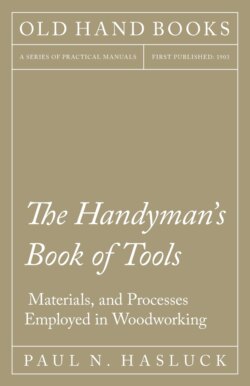Читать книгу The Handyman's Book of Tools, Materials, and Processes Employed in Woodworking - Paul N. Hasluck - Страница 140
На сайте Литреса книга снята с продажи.
THE SCRAPER DESCRIBED.
ОглавлениеThe scraper is a thin and very hard steel plate, about 5 in. by 3 in., or 4 1/2 in. by 2 1/2 in., and slightly less than 1/16 in. in thickness. The long edges are sharpened in a peculiar manner. Both of the long edges may be straight, as in Fig. 411 and at A B, Fig. 413, or one edge may have round corners of differing radii, as at C D. These corners are often useful in working up hollows and mouldings generally. The “straight” edge A B, it will be noticed, is not quite straight throughout its whole length. Near the ends the edge is gradually rounded off, to prevent the corners catching in the surface that is being operated on. In this respect, the commercial scraper (Fig. 411) is incorrectly shaped. The cutting power of a scraper depends upon, first, the quality and temper of the steel of which it is made; and, secondly, upon the proper formation of the burr or feather along its edges. Also, the faces of the steel plate must be perfectly bright and free from rust marks or indentations of any kind. It is by no means an uncommon thing to find any rusty piece of sheet steel—a piece of an old hand-saw or try-square, for example—being used as a scraper. The smallest appreciation of how the scraper cuts would indicate how useless such material is for this particular purpose. On the other hand, scarcely anything better can be found for making a scraper than a piece of broken saw-blade, provided the sides of it are still polished and bright. The fact that the saw was broken may often be taken to indicate a greater hardness than usual in the blade, thus fitting it exactly for the purposes of a scraper. An ordinary saw-blade is not usually hard enough. Provided that there is enough elasticity to “give” in the operator’s hands as it is being pushed along, the scraper should be nearly too hard for an ordinary file to touch. If it can be filed easily, then its edge will soon be gone. At the same time, if the steel is merely hard, without the desired amount of elasticity, the burr edge will strip off as soon as it is applied to the work, leaving a coarse, jagged, and utterly useless edge behind.
Fig. 412.—Handled Steel Scraper.
Fig. 413.—Correctly Shaped Steel Scraper.
Fig. 414.—Diagram showing Action of Scraper.
